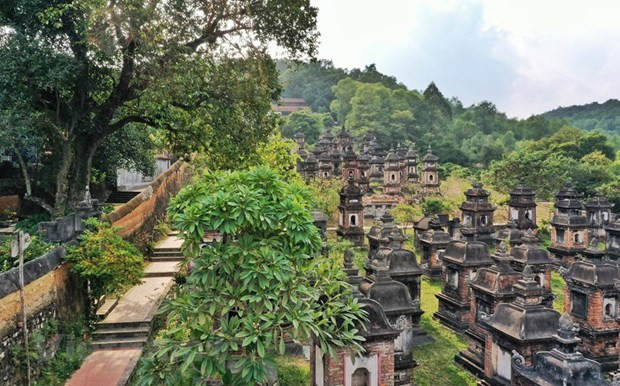 The pagoda covers a large area, consisting of three main zones: a garden, a main worshipping hall, and a tower garden. (Photo: VNA)
The pagoda covers a large area, consisting of three main zones: a garden, a main worshipping hall, and a tower garden. (Photo: VNA)Lying on Phuong Hoang (Phoenix) Mountain and facing the Cau River, Bo Da, alsoknown as Duc La, Pagoda is among the most major centre of Truc Lam ZenBuddhism.
The pagoda was built in the 11th century, under the Ly dynasty butbadly damaged during wars in subsequent centuries. Not until the Le dynastyunder King Le Du Tong (1705 – 1728) was the pagoda reconstructed and more orless retains the shape it has today.
Compared to other pagodas in northern Vietnam, Bo Da is unique for itsarchitecture.
It appears to be a closed complex from the outside yet features hundreds ofcompartments that all open into one another on the inside. The special structureprovides visitors with a sacred, secluded refuge from the outside world.
“Bo Da pagoda isremarkable for its feng shui characteristics, architecture, woodblocks,guardian god statues, and the largest tower garden in Vietnam,” said VenerableThich Tuc Vinh, who is abbot of Bo Da Pagoda.
The pagoda covers a large area, consisting of three main zones: a garden, amain worshipping hall, and a tower garden.
The main worshipping hall was built upon typical architecture of Northern Vietnam’spagodas with eight doors and the Luc-shaped (Chinese word for number 6) entrance.
The thousand-year-oldtower garden is located outside the worshipping hall, encircled by an old brickwall. Inside 97 towers is the bone-ash and sarira of 1,214 monks and nuns. Thistower garden is regarded as the largest and most beautiful of its kind inVietnam.
What makes the pagoda special is that it is a place of worship not onlyBuddhism but also Confucianism and Taoism, which is called “Tam giao Dongnguyen” (or three religions harmonising as one).
The pagoda is also home over 2,000 Sutra woodblocks, arranged in eightbookcases. To date, hardly any of them have ruined.
The Bo Da pagoda was recognised as Vietnam’s special national relic site in2016./.




























